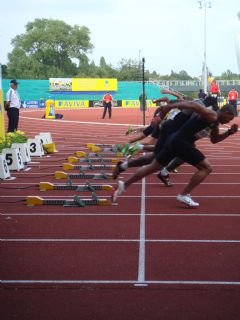A
study released this month in The Journal of Strength & Conditioning
Research compared the effects of incorporating resisted & assisted training
into sprints sessions. The author, from Texas Christian University in
Fort Worth, found that, whilst resisted & assisted sprint training both increase
sprint speed, assisted sprint training is best for increasing
"first-step" quickness.
The press release by Wolters Kluwer Health promotes the study, published in the October issue of The Journal of Strength & Conditioning Research (link below), reporting that the two specialized training techniquesóresisted and assisted sprint trainingóboth lead to faster sprint speeds in high-level female soccer players.
However, the effects differ depending on
acceleration distance, suggesting that the choice of speed enhancement
techniques should be sport-specific. For sports like soccer that require
"first-step" quickness, assisted sprint training is more likely to
produce the desired result, according to the report by David E. Upton, Ph.D.,
of Texas Christian University.
Dr. Upton compared the effects of different sprint training programs in 27 NCAA
Division IA female soccer players. After initial testing of 40-yard sprint
speed, the women were randomly assigned to three different sprint training
groups. One group received resisted sprint training, in which they ran against
resistance. Another group received assisted sprint training, in which they ran
with assistance.
The resisted and assisted drills were performed using specially designed
harnesses, which allowed trainers to either pull against or pull with the
athletes as they ran. The effect is comparable to running uphill (resisted
training) or downhill (assisted training). Both techniques have been reported
to improve sprint speeds, although the effects on performance have been
inconclusive.
A third group received traditional
sprint training, with no resistance or assistance. All training programs lasted
for four weeks (twelve sessions).
Both resisted and assisted spring
training led to significant increases in sprint speed. Overall 40-yard speed
increased by 0.08 meters per second per meter with assisted training and 0.06
meters per second per meter with resisted training. For athletes receiving
traditional sprint training, speed was unchanged.
Although the assisted and resisted
training methods produced similar improvements in 40-yard sprint speed, the
split times showed some significant differences. The assisted training group
had significant increases in speed from 5 to 15 yards, compared to no change in
this distance in the resisted training group.
In contrast, the resisted training group
had increased speed from 25 to 40 yards, compared to no change in the assisted
training group. The assisted training group had increased acceleration during
the first 15 yards of the 40-yard sprint, while the resisted training group had
increased acceleration during the final 25 yards.
"That is, the training modalities
impact maximal velocity differentially as a result of their net effect on the
rate of change in velocity, or acceleration, over the total distance
covered," Dr. Upton explains. The improvement in initial quickness with
assisted training may reflect "enhanced neuromuscular facilitation"
in response to training at faster-than-normal (supramaximal) speeds.
From a practical
standpoint, the choice of resisted versus assisted training may depend on the
requirements of the individual sport. In soccer, initial acceleration is an
important key to separating from or closing on an opposing player.
Thus assisted sprint training may be an effective way of developing "first-step quickness" in soccer players, whereas resisted training would be a good choice for a football wide receiver who needs to turn on the speed when running downfield. "Strength and conditioning professionals might consider using a combination of protocols, perhaps switching off between different days," Dr. Upton adds.
Enjoy the read & post your thoughts in the comments section below!

